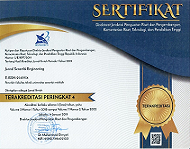Molecular Dynamics Simulation and Mechanical Property Analysis of Unsaturated Polyester/Glass Fiber Composites
Keywords:
Unsaturated Polyester, Fiberglass, Molecular DynamicsAbstract
Composite materials are essential for engineering applications due to their superior mechanical properties. Unsaturated polyester reinforced with glass fiber is widely used but optimizing its mechanical performance remains challenging. This study combines experimental testing and molecular dynamics (MD) simulations to investigate the mechanical properties of unsaturated polyester/glass fiber composites. Composites were fabricated with varying glass fiber volume fractions, and their impact strength and density were tested. The results showed an optimal glass fiber fraction at 12.5%v, achieving the highest impact strength (142.80 kJ/m²) and increased density (1.4408 g/cm³). MD simulations validated these findings, highlighting the role of van der Waals forces in molecular aggregation and interfacial bonding. This study bridges experimental and MD computational insights, recommending the simulation of treated glass fiber in the future to explore the potential of treated glass fibers in enhancing the interfacial bonding and overall mechanical performance of unsaturated polyester/glass fiber composites.
References
[1] S. Devaraju and M. Alagar, “Chapter 2 - Unsaturated Polyester—Macrocomposites,” in Unsaturated Polyester Resins, S. Thomas, M. Hosur, and C. J. Chirayil, Eds., Elsevier, 2019, pp. 43–66. doi: https://doi.org/10.1016/B978-0-12-816129-6.00002-8.
[2] S. A. Rahmawaty, A. W. Y. P. Parmita, and A. Dwi, “Analisa Kekuatan Tarik dan Tekuk pada Komposit Fiberglas-Polyester Berpenguat Serat Gelas dengan Variasi Fraksi Volume Serat,” JTM-ITI (Jurnal Teknik Mesin ITI), vol. 5, no. 3, pp. 146–155, 2021.
[3] L. Widodo, K. Priyanto, and B. Margono, “Analisis Ketangguhan Impak Komposit Polyester Berpenguat Serat daun nanas berdasarkan jenis anyaman,” Journal Teknika, vol. 7, no. Vol. 7 No. 4 (2022): October 2022, Oct. 2022, doi: DOI:https://doi.org/10.52561/teknika.v7i4.207.
[4] M. Fakhruddin, I. Mashudi, M. Muzaki, H. Firmansyah, B. Pranoto, and H. Wicaksono, “Pengaruh Fraksi Volume Terhadap Sifat Mekanis Komposit Forged Fiberglass Metode Compression Mould,” Jurnal Energi dan Teknologi Manufaktur (JETM), vol. 5, pp. 35–40, Dec. 2022, doi: 10.33795/jetm.v5i02.134.
[5] P. Wang et al., “Molecular dynamics simulation of the interfacial bonding properties between graphene oxide and calcium silicate hydrate,” Constr Build Mater, vol. 260, p. 119927, 2020, doi: https://doi.org/10.1016/j.conbuildmat.2020.119927.
[6] S. Sharma, An Introduction to Molecular Dynamics Simulation of Polymer Composites. Nova Science Publishers, Inc., 2020. doi: 10.52305/LWUR4972.
[7] Y. Yan et al., “Molecular dynamics simulation of the interface properties of continuous carbon fiber/ polyimide composites,” Appl Surf Sci, vol. 563, p. 150370, Jun. 2021, doi: 10.1016/j.apsusc.2021.150370.
[8] B. Cherian and E. Thachil, “Synthesis of unsaturated polyester resin - Effect of choice of reactants and their relative proportions,” International Journal of Polymeric Materials - INT J POLYM MATER, vol. 53, pp. 829–845, Oct. 2004, doi: 10.1080/00914030490502364.
[9] J. Grimalt, L. Frattini, P. Carreras, and V. Fombuena, “Optimizing rheological performance of unsaturated polyester resin with bio-based reactive diluents: A comprehensive analysis of viscosity and thermomechanical properties,” Polym Test, vol. 129, p. 108264, 2023, doi: https://doi.org/10.1016/j.polymertesting.2023.108264.
[10] É. S. Souza, C. A. Kuhnen, B. da S. Junkes, R. A. Yunes, and V. E. F. Heinzen, “Quantitative structure–retention relationship modelling of esters on stationary phases of different polarity,” J Mol Graph Model, vol. 28, no. 1, pp. 20–27, 2009, doi: https://doi.org/10.1016/j.jmgm.2009.03.003.
[11] S. Boyde, “Esters,” in Synthetics, Mineral Oils, and Bio-Based Lubricants, CRC Press, 2020, pp. 45–76.
[12] J. G. Speight, “Chapter 2 - Organic Chemistry,” in Environmental Organic Chemistry for Engineers, J. G. Speight, Ed., Butterworth-Heinemann, 2017, pp. 43–86. doi: https://doi.org/10.1016/B978-0-12-804492-6.00002-2.
[13] L. W. McKeen, “1 - Introduction to Plastics, Polymers, and Their Properties,” in The Effect of Temperature and other Factors on Plastics and Elastomers (Third Edition), L. W. McKeen, Ed., Oxford: William Andrew Publishing, 2014, pp. 1–45. doi: https://doi.org/10.1016/B978-0-323-31016-1.00001-5.
[14] J. N. Israelachvili and D. Tabor, “Van der Waals Forces: Theory and Experiment,” in Progress in Surface and Membrane Science, vol. 7, J. F. DANIELLI, M. D. ROSENBERG, and D. A. CADENHEAD, Eds., Elsevier, 1973, pp. 1–55. doi: https://doi.org/10.1016/B978-0-12-571807-3.50006-5.
[15] V. E. Ogbonna, A. P. I. Popoola, O. M. Popoola, and S. O. Adeosun, “A review on corrosion, mechanical, and electrical properties of glass fiber-reinforced epoxy composites for high-voltage insulator core rod applications: challenges and recommendations,” Polymer Bulletin, vol. 79, no. 9, pp. 6857–6884, 2022, doi: 10.1007/s00289-021-03846-z.
[16] J. Graham-Jones and J. Summerscales, “1 - Introduction,” in Marine Applications of Advanced Fibre-Reinforced Composites, J. Graham-Jones and J. Summerscales, Eds., Woodhead Publishing, 2016, pp. 1–15. doi: https://doi.org/10.1016/B978-1-78242-250-1.00001-6.
[17] K. Hasan, M. Islam, S. Al Azad, M. I. Iqbal, and J.-H. Wu, “Dynamic Mechanical Behavior & Analysis of the Jute-Glass Fiber Reinforced Polyester Hybrid Composites,” American Journal of Applied Physics, vol. 1, pp. 1–12, Nov. 2016.
[18] F. R. Jones and N. T. Huff, “19 - The structure and properties of glass fibers,” in Handbook of Properties of Textile and Technical Fibres (Second Edition), A. R. Bunsell, Ed., Woodhead Publishing, 2018, pp. 757–803. doi: https://doi.org/10.1016/B978-0-08-101272-7.00019-5.
[19] A. Alipour and K. Jayaraman, “Performance of Flax/Epoxy Composites Made from Fabrics of Different Structures,” Fibers, vol. 12, no. 4, 2024, doi: 10.3390/fib12040034.
[20] H. Fallahi, O. Kaynan, and A. Asadi, “Insights into the effect of fiber–matrix interphase physiochemical- mechanical properties on delamination resistance and fracture toughness of hybrid composites,” Compos Part A Appl Sci Manuf, vol. 166, p. 107390, 2023, doi: https://doi.org/10.1016/j.compositesa.2022.107390.
[21] J. Qiao, Q. Zhang, C. Wu, G. Wu, and L. Li, “Effects of Fiber Volume Fraction and Length on the Mechanical Properties of Milled Glass Fiber/Polyurea Composites,” Polymers (Basel), vol. 14, no. 15, 2022, doi: 10.3390/polym14153080.
[22] D. Lee and S. CHEON, “Impact Characteristics of Glass Fiber Composites with Respect to Fiber Volume Fraction,” Journal of Composite Materials - J COMPOS MATER, vol. 35, pp. 27–56, Jan. 2001, doi: 10.1177/002199801772661858.
[23] H. Çuvalci, K. Erbay, and H. İpek, “Investigation of the Effect of Glass Fiber Content on the Mechanical Properties of Cast Polyamide,” Arab J Sci Eng, vol. 39, pp. 9049–9056, Nov. 2014, doi: 10.1007/s13369-014-1409-8.
[24] N. Mohd Nurazzi, A. Khalina, S. M. Sapuan, A. M. Dayang Laila, and M. Rahmah, “Curing behaviour of unsaturated polyester resin and interfacial shear stress of sugar palm fibre,” Journal of Mechanical Engineering and Sciences, vol. 11, no. 2, pp. 2650–2664, Jun. 2017, doi: 10.15282/jmes.11.2.2017.8.0242.
[25] V. M. Rao, R. Sanghvi, and H. (Jim) Zhu, “Chapter 1 - Solubility of Pharmaceutical Solids,” in Developing Solid Oral Dosage Forms, Y. Qiu, Y. Chen, G. G. Z. Zhang, L. Liu, and W. R. Porter, Eds., San Diego: Academic Press, 2009, pp. 1–24. doi: https://doi.org/10.1016/B978-0-444-53242-8.00001-1.
[26] K. Nordlund et al., “Primary radiation damage: A review of current understanding and models,” Journal of Nuclear Materials, vol. 512, pp. 450–479, 2018, doi: https://doi.org/10.1016/j.jnucmat.2018.10.027.
[27] K. A. Thompson, “Relativity, Special,” in Encyclopedia of Physical Science and Technology (Third Edition), R. A. Meyers, Ed., New York: Academic Press, 2003, pp. 117–141. doi: https://doi.org/10.1016/B0-12-227410-5/00657-8.
[28] S. Moondra, R. Maheshwari, N. Taneja, M. Tekade, and R. K. Tekadle, “Chapter 6 - Bulk Level Properties and its Role in Formulation Development and Processing,” in Dosage Form Design Parameters, R. K. Tekade, Ed., Academic Press, 2018, pp. 221–256. doi: https://doi.org/10.1016/B978-0-12-814421-3.00006-3.
[29] R. V Mantri, R. Sanghvi, and H. (J. ) Zhu, “Chapter 1 - Solubility of Pharmaceutical Solids,” in Developing Solid Oral Dosage Forms (Second Edition), Y. Qiu, Y. Chen, G. G. Z. Zhang, L. Yu, and R. V Mantri, Eds., Boston: Academic Press, 2017, pp. 3–22. doi: https://doi.org/10.1016/B978-0-12-802447-8.00001-7.
[30] Y. Sun, Q.-H. Shi, L. Zhang, G.-F. Zhao, and F.-F. Liu, “2.47 - Adsorption and Chromatography,” in Comprehensive Biotechnology (Second Edition), M. Moo-Young, Ed., Burlington: Academic Press, 2011, pp. 665–679. doi: https://doi.org/10.1016/B978-0-08-088504-9.00123-9.
[31] E. Hadjittofis, S. C. Das, G. G. Z. Zhang, and J. Y. Y. Heng, “Chapter 8 - Interfacial Phenomena,” in Developing Solid Oral Dosage Forms (Second Edition), Y. Qiu, Y. Chen, G. G. Z. Zhang, L. Yu, and R. V Mantri, Eds., Boston: Academic Press, 2017, pp. 225–252. doi: https://doi.org/10.1016/B978-0-12-802447-8.00008-X.
[32] A. Gavezzotti, “Chapter 4 - The organic crystal potential: History, development, and today’s cost/performance ratios,” in Theoretical and Computational Chemistry, vol. 20, A. Gavezzotti, Ed., Elsevier, 2021, pp. 85–113. doi: https://doi.org/10.1016/B978-0-12-823747-2.00003-2.
Downloads
Published
Issue
Section
License
Copyright (c) 2024 Desi Budi Ariani, Silvia, Malvin Shafwan Aziz (Author)

This work is licensed under a Creative Commons Attribution 4.0 International License.
















